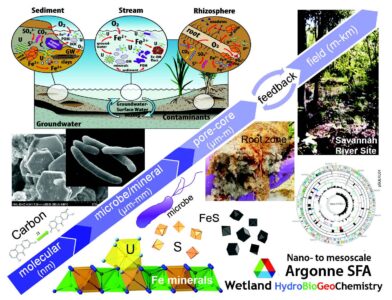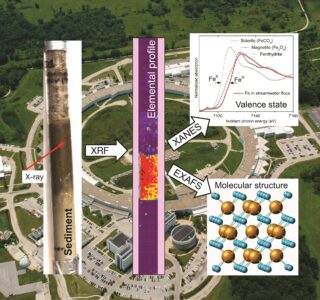Elucidating the hydrologically driven biogeochemical processes that control water quality within wetland environments
Project website | Overview brochure PDF
- Principal investigators: Ken Kemner and Ed O’Loughlin
- Annual reports: 2019 | 2017 | 2016 (Note: Reports are not issued during SFA review years.)
Within wetlands, the movement of water and the biogeochemically catalyzed transformations of its constituents determine the mobility of nutrients and contaminants, greenhouse gas emissions into the atmosphere, carbon cycling and sequestration in subsurface environments, and water quality. In addition to carbon, iron and sulfur are also abundant elements often found in wetlands. Their redox cycling is driven largely by microbial activity, and they are a significant component of major and minor elemental cycling and energy flux. In addition to greatly affecting elemental cycling and transport, wetlands provide many critical ecosystem services. However, the explicit, hydrologically driven wetland biogeochemical functions that control carbon, nutrient, and contaminant cycling and water quality are still not well enough understood to be adequately modeled.

Multiscale Hydro-biogeochemistry. The Argonne Wetland Hydro-biogeochemistry SFA is developing a mechanistic understanding of hydrologically driven molecular- (subnanometer) to core-scale (~meter) biogeochemical transformations within redox-dynamic environments such as wetlands, as well as the effects of hydrologically driven iron (Fe) and sulfur (S) biogeochemistry on water quality. These investigations are being pursued with an acute appreciation of how these smaller-scale processes can lead to emergent properties at the landscape scale. Key: SO42-, sulfate; CO2, carbon dioxide; POM, particulate organic matter; U, uranium; DOC, dissolved organic carbon; GW, groundwater; OM, organic matter.
A Science Focus Area (SFA) project led by Argonne National Laboratory is investigating wetland hydro-biogeochemistry on a riparian wetland field site at the Department of Energy’s (DOE) Savannah River Site (SRS) in Aiken, South Carolina. This site is representative of many riparian wetlands found in humid regions of the Southeast that have carbon-rich soils and high iron content. However, this site is unique in that it received large amounts of contaminant metals (nickel, chromium, copper, and lead) and uranium. Researchers have identified three major components within these wetlands—sediment, rhizosphere, and stream—that contain the hydrologically driven biogeochemical forces and determine water quality.
The project’s long-term vision is to develop a mechanistic understanding of and ability to model the coupled hydrological, geochemical, and biological processes controlling water quality in these wetlands, as well as the implications of these processes for watersheds commonly found in humid U.S. regions. The project is supported by DOE’s Office of Biological and Environmental Research (BER) as part of BER’s Environmental System Science (ESS) program. ESS’s goal is to advance understanding of terrestrial ecosystems and watersheds, which include interdependent microbial, biogeochemical, ecological, hydrological, and physical processes across spatiotemporal scales.
Key Knowledge Gaps
From nanometer to meter scales, the Wetland Hydro-biogeochemistry SFA seeks to identify and understand hydrologically driven biogeochemical processes that create redox dynamic conditions and are a major driver of groundwater and surface water quality within riparian wetland environments.
SFA research addresses two thematic critical knowledge gaps related to accomplishing this goal:
-
- Molecular-scale biogeochemical processes that affect iron, carbon, and contaminant speciation within the wetland sediment, rhizosphere, and stream environments.
- Hydrologically driven biogeochemical controls on the mass transfer of iron, carbon, and contaminants within wetland sediment, rhizosphere, and stream environments.

Integration of Bioinformatic Approaches into Hydro-biogeochemistry. The Argonne SFA develops and uses omics-based approaches to understand microbially driven controls on hydro-biogeochemical processes in the field. The biogeochemical transformations performed by individual organisms, consortia, and communities are determined with sequencing technologies, model development, and bioinformatic approaches.

Synchrotron-Based Hydro-biogeochemistry. (Overlay) The spatial heterogeneity of molecular-scale information within sediment cores can be gathered via X-ray measurements made at the Advanced Photon Source. Synchrotron-based approaches are used to develop molecular- to core-scale mechanistic understanding of the role of hydrologically driven and coupled iron and carbon biogeochemical processes on nutrient and contaminant cycling and controls on water quality. Key: XANES, X-ray absorption near-edge structure; EXAFS, extended X-ray absorption fine structure; XRF, X-ray fluorescence.
Integrating Synchrotron- and Omics-Based Lab and Field Biogeochemistry
Strong emphasis on integrated lab- and field-based experimental research and field monitoring enables the derivation of key model parameters and the development of modeling approaches to predict wetland controls on water quality. Materials collected from sediment, rhizosphere, and stream environments within wetlands are analyzed to identify major hydrologically driven biogeochemical processes that affect surface and groundwater quality. Besides standard analytical approaches, unique capabilities—including synchrotron-based approaches at Argonne’s Advanced Photon Source (APS), omics-based approaches and collaborative research with DOE Systems Biology Knowledgebase (KBase) researchers at Argonne and Lawrence Berkeley national laboratories, and mass spectrometry–based approaches to characterize carbon chemistry through collaboration with scientists at BER’s Environmental Molecular Sciences Laboratory—are used to analyze field and laboratory materials. In addition, SFA experimental work drives optimization of synchrotron-based techniques at APS beamlines with the characteristics required for the project, thereby increasing X-ray beamline productivity while also benefitting the larger international synchrotron-based biogeochemistry research community.
Merging Experimental and Modeling Approaches
Initial modeling approaches focus on reactive transport models (RTMs) of lab-based, mixed-batch reactors; diffusive and advective flow experiments; and small-scale field observations. RTMs are supplemented with metabolic modeling of microorganisms and interacting consortia to more accurately capture the role of microbial communities in mediating biogeochemical transformations. These models are used for hypothesis testing and to analyze the sensitivity of hydro-biogeochemical processes in determining water quality. A preliminary hydrological model has already been developed for the SRS watershed that contains the wetland study site. It provides key insights and data related to surface and groundwater flow within the watershed and is critical for identifying the hydrological drivers of the biogeochemical processes to be integrated into RTMs. The iterations between lab- and field-based experiments in concert with modeling improve both aspects of the SFA research.

